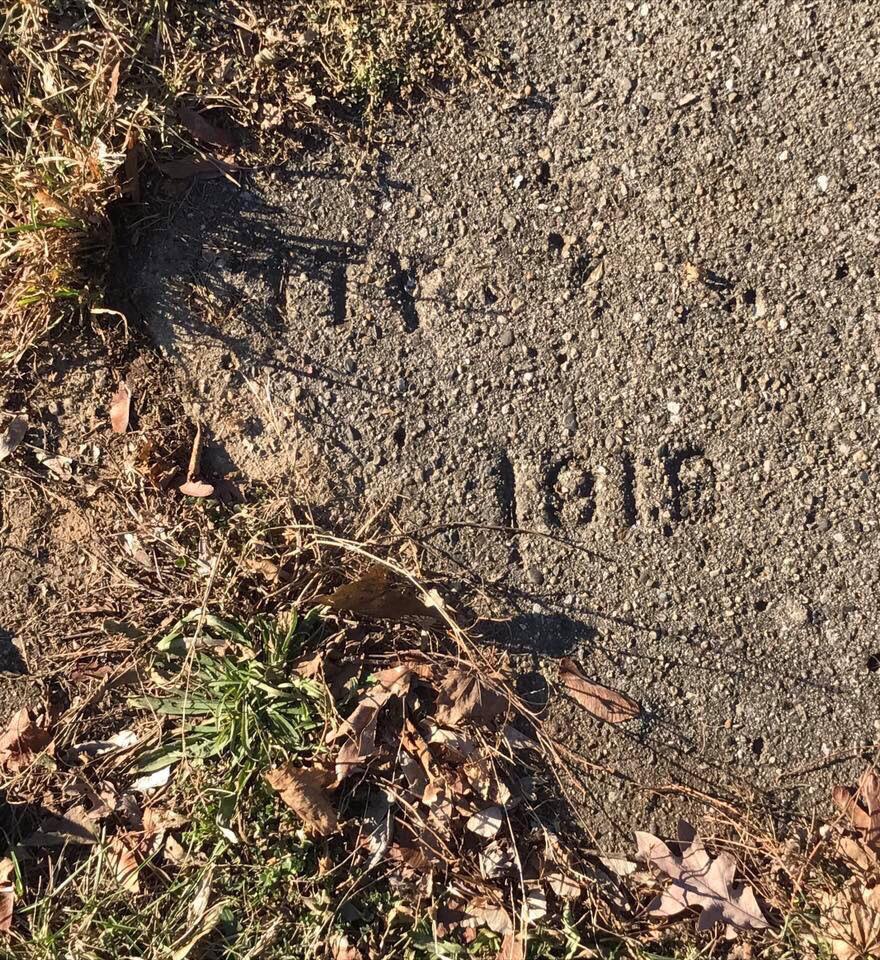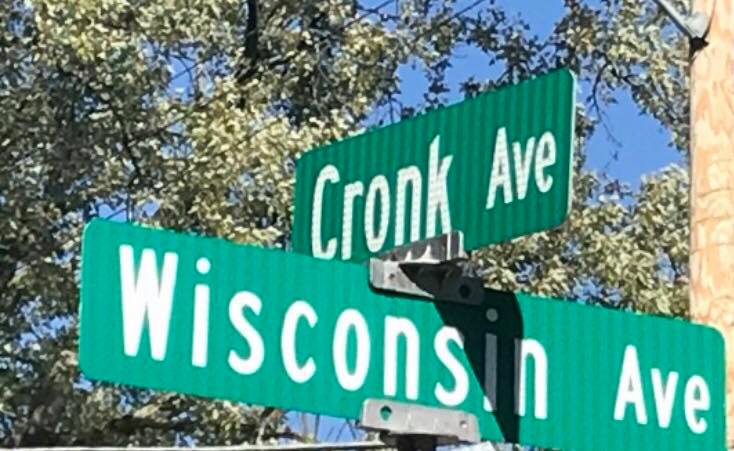By Gary Fisher
They’re just metal street signs. Been there for years, decades, a very long time, after all. There they are perched at the top of a standard street sign pole.
Nothing to see here, folks.
Or maybe there is. Well at least for me there is. That’s because sometimes street signs aren’t just street signs. Sometimes they are so much more. Those two signs were the literal and figurative signposts of not only my life, but also scores of other lives for the last 100 years.

(Photo by Gary Fisher)
The date is stamped on the sidewalk right below the sign: 1919. That’s the year they poured the concrete, laid out the avenue, and decided it should be a place where people lived. Modest homes with tidy yards, two bedrooms and a single bathroom so tiny you could turn on the shower, flush the toilet, and brush your teeth in the sink–simultaneously (I did this literally thousands of times). Homes with a true Michigan basement that were home to hard working folks. Immigrants from Europe, migrants from the deep south, young families, and natives alike.
The signs bear the name of a state and of a person. Wisconsin and Cronk, juxtaposed just so across one another, a corner on the “Ave.” So it was that situated at the corner of Wisconsin and Cronk Avenues on the Eastside of Flint was a “University” of sorts. Like a typical place of higher education it was a place where learning took place. It was a place where lessons were learned. The signs that seemed so benign were anything but.
To wake up every day and look at those signs told you some things. They told you where you lived for sure. They even told you how you lived. If you looked up and saw those signs, your family probably relied in some way or the other on one of the Earth’s greatest factory complexes located just a few blocks away, there were two close by, both east and west. General Motors and Buick’s first factory to the west, and AC Spark Plug to the east.

(Photo by Gary Fisher)
If you saw those signs you knew you were at a crossroads of the American experience of the 20th century. From a cartographer’s perspective you were somewhere in the hazy epicenter of it all. You were in the half way point between those two goliaths of the American Arsenal of Democracy, slanted somewhere between the tip of that Buick factory and the Lewis and Leith Street Neighborhoods, and the white collar Court Street/East Village. Just a bit to the south and east was the predominantly black part of the East Side- once called Floral Park (although no one I know who lived there ever heard it called that) and long known as “The 9th Street” area in my ‘hood. I knew my way around them all. How could I not? I was living in the traffic station centrifuge. A weigh station of sorts – right there on the corner.
In the summer I could step out on to my back porch and take a deep breath in and smell equal parts Buick paint jobs and drop forge refuse exhaust and Angelo’s Coney Islands and French fries. They both smelled like home to me–especially Angelo’s because that was just two quick blocks away. Two blocks to the fries and gravy. Two blocks to the pure delight of the ultimate community meeting place. Glance at the signs and you knew you were dwelling in a special place. Blue collar and white collar. Rich and poor. Black and white.
The American Century and a helluva hotdog
The signs were there when those factories were being built up. When the first denizens graced the slapped up houses built specifically for the immigrant residents. From Poland, and Russia. From Germany and Canada. The Scots – Irish from Missouri, Tennessee, and Arkansas. All mashed together in that little neighborhood. The lawns were mostly well manicured. The houses kept up. Little gardens, picket fences, tidy patches of the American Dream, nestled together in a universal understanding of our status, or comprehensive lack thereof.
Saying a neighborhood is a “family” sounds clichéd at best, and a fantastical bit of memory whitewashing at worst. But there it was. We may have done a little bit of fighting amongst ourselves, but outsiders better leave us alone–or they’d get all of us.
I remember one poor soul in particular who learned that lesson the hard way. He rode the city bus looking for a victim and found a good one in an elderly lady at the corner of Ohio and Franklin Avenues, and so he mugged her. Hit her and grabbed her purse. Then he ran down Ohio Avenue, turned right, headed towards those two signs–Wisconsin and Cronk. So he ran past my buddies and me, swigging on big glass bottles of Mountain Dew. He was wearing a baby blue sweat suit and carrying a purse. As our jaws dropped, gazes switched to the man in the brown plaid sport coat running after him yelling “Did you see a guy in a sweat suit carrying a purse run by? He hit my mom and stole her purse!” We jumped on our homemade motocross bikes and gave chase. We were soon joined by the Vietnam vet Vic who lived on the corner, the former FBI agent Ward Trevarthen in his car, and a bunch of long haired stoners who leapt off of the couch on their porch.
We caught him just as he made a sprint towards Kearsley Park. When the cops showed up my buddy Knight and I had the purse and were being interviewed by the Flint Journal writer who showed up on the scene. We were rather pleased with ourselves and best of all we felt a little heroic. Everyone was laughing and slapping backs and hands. Good deed done. That had never happened before and its fair to say it never happened again. I’m not sure I ever felt more like a member of an extended family than I did that day.
We talked about our city with pride, and especially about our part of the city. That part–that side–the Eastside. It was one word to us–like a city: “Where do I live? The Eastside.” And there were daily lessons to learn there. My folks were often the professor’s for not just my sister Vickie and I, but many of the kids in the hood. My mom was the neighborhood lunch lady. The Homeroom Mom. The official chauffeur to all ball games. She taught my buddy Dennis how to tie his shoes. Damn near raised several other neighborhood kids. She was there to bail them out of trouble, listen to their problems, loan a couple of bucks, or make a peanut butter and jelly sandwich. I learned what it meant to be there for someone – to really be there.
My dad was the gym teacher, boxing coach, and my personal big brother back up if fights became unfair. You could fight sure, but it had to be clean and most of all it had to be fair. He also made sure we had lots of sports stuff, all of the equipment and balls and bats. My folks liked knowing where I was so we had a little pool in the summer. We had a swing set and a whirly bird. They encouraged my entrepreneurial instincts and I wrote and distributed a handwritten newspaper called “The Neighborhood News” (my investigative journalism caught the neighborhood peeping Tom). I ran a carnival in my backyard (we hired entertainment and security guards, i.e. the “older guys”), and I was the neighborhood paper boy for the Flint Journal. Talk about a business education!
My folks let us wear the yard out playing football and baseball on the side yard, soccer in the backyard, and endless games of catch on the front yard. My pals and I wore the grass down to dirt. We played “round up” until 11 on summer nights and had to duck a cop car or two because some neighbors weren’t thrilled with kids on their roof at 11 p.m. We “found” some orange cones and made goals for street hockey on Wisconsin, and used spray paint to make yard markers for street football. I left a lot of skin on Wisconsin Avenue. But far more crucial was what I picked up, and that made all the difference.
I came to understand loyalty, trust, and honor. I was educated on the fine art of building coalitions, organizing, leadership and communicating. I got a Ph.D. in relationships and many of those street football, Mountain Dew chugging, bike patrol partners are still close friends today. We were proud to be from Flint, proud to be from the East Side, and pride mattered – a lot.

Gary Fisher (photo by Jenny Lane Studios)
But the most valuable thing I learned was love. What it meant to love where you lived, who you lived with, what it meant to be loved, to love your neighbors, and to feel the warm embrace of being from somewhere, and belonging to something: A city, a community, a family. It wasn’t hard to do. If I ever needed a reminder I just had to look up at those green signs and it all made sense.
Gary L. “Fish” Fisher was born and raised in the city and has lived in the area most of his life, residing in both the East Side and East Village neighborhoods. His family has been a part of the Flint area for over 100 years. In fact, they were in Flint when General Motors got its start; his great-grandfather, grandfathers, grandmother, and dad (along with numerous cousins, uncles, and aunts) all worked for GM, most of them at “The Buick.” His fascination with the history of the city has existed as long as he can remember. Fisher moved his financial planning business into the Mott Foundation building during the water crisis in part as a show of support and solidarity for his hometown, he says, and has been there for three years. He is a trustee on the board of the Genesee County Historical Society and hosts a radio show on WFNT-AM 1470 every Wednesday at 11 a.m. Eastern called “ Fish and The Flint Chronicles.” He asserts Flint has produced the best cars, athletes, and coney islands the world has ever known–and the toughest people! Fisher can be reached at ply2win2006@aol.com.



You must be logged in to post a comment.